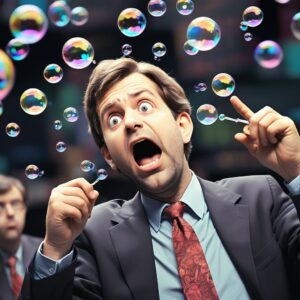Market psychology plays a crucial role in driving stock market bubbles and crashes. Understanding how investor sentiment, herd behavior, and irrational exuberance contribute to these phenomena is essential for investors and market participants. In this guide, we’ll explore the impact of market psychology on stock market bubbles and crashes.

Understanding Market Psychology:
1. Investor Sentiment:
- Greed and Fear: Investor sentiment oscillates between greed and fear, driving market cycles. During bull markets, optimism and greed prevail, leading to asset price inflation and speculative buying. Conversely, during bear markets, fear and pessimism dominate, triggering selling pressure and price declines.
2. Herd Behavior:
- Follow the Crowd: Herd behavior refers to the tendency of individuals to mimic the actions of the majority, often driven by fear of missing out (FOMO) or fear of losses. This collective behavior can amplify market trends, leading to bubbles during periods of irrational exuberance and crashes when sentiment abruptly reverses.
3. Confirmation Bias:
- Seeking Validation: Investors tend to seek information that confirms their existing beliefs or biases while ignoring contradictory evidence. This confirmation bias can reinforce market trends and contribute to the formation of bubbles as investors dismiss warning signs and rationalize excessive valuations.
4. Overreaction and Underreaction:
- Emotional Responses: Market participants often overreact to news and events, leading to exaggerated price movements. This overreaction can create buying or selling opportunities for contrarian investors. Conversely, markets may underreact to new information, delaying price adjustments and prolonging trends.
Stock Market Bubbles:
1. Characteristics:
- Excessive Valuations: Bubbles are characterized by asset prices that significantly exceed their intrinsic values, driven by speculative buying and irrational exuberance.
- Widespread Participation: Bubbles often involve widespread participation from retail and institutional investors, fueled by positive feedback loops of rising prices and euphoria.
- Media Hype: Media coverage and public fascination with market winners contribute to the amplification of bubbles, attracting more participants and fueling the mania.
2. Examples:
- Dot-com Bubble: The late 1990s witnessed a speculative frenzy in internet-related stocks, fueled by unrealistic growth expectations and investor euphoria. The bubble burst in early 2000, leading to significant losses for investors.
- Housing Bubble: The mid-2000s housing bubble saw a surge in real estate prices driven by lax lending standards, securitization of subprime mortgages, and speculative buying. The subsequent collapse triggered the global financial crisis of 2008.
Stock Market Bubbles Crashes:
1. Causes:
- Panic Selling: Crashes are often triggered by sudden shifts in investor sentiment, leading to panic selling and sharp declines in asset prices.
- Leverage and Margin Calls: Excessive leverage and margin debt can exacerbate market downturns as forced liquidations amplify selling pressure.
- Systemic Risks: Crashes may result from systemic risks such as financial imbalances, economic recessions, geopolitical events, or unexpected shocks to the financial system.
2. Examples:
- Black Monday (1987): The stock market crash of October 19, 1987, saw the Dow Jones Industrial Average plummet by over 22% in a single day, fueled by program trading, portfolio insurance strategies, and investor panic.
- Global Financial Crisis (2008): The collapse of Lehman Brothers in September 2008 triggered a widespread financial meltdown, leading to a severe bear market, bank failures, and a global recession.
Conclusion:
Market psychology exerts a powerful influence on stock market bubbles and crashes, driving cycles of optimism and pessimism among investors. Bubbles form when investor sentiment becomes detached from fundamental valuations, leading to unsustainable price increases. Crashes occur when sentiment abruptly shifts, triggering panic selling and precipitous declines in asset prices. Recognizing the role of market psychology and understanding the warning signs of bubbles and crashes is essential for prudent investing and risk management.
